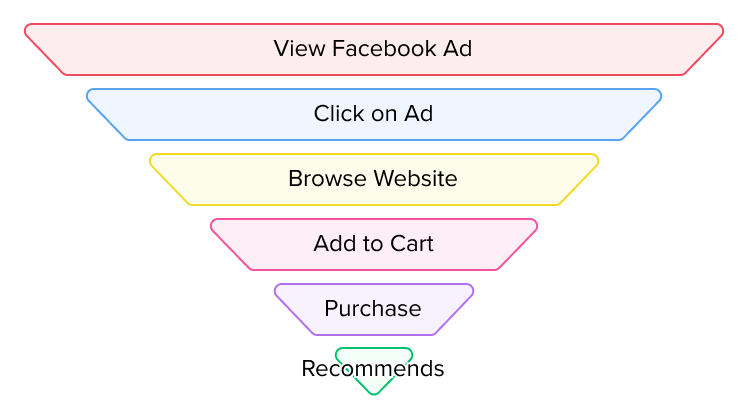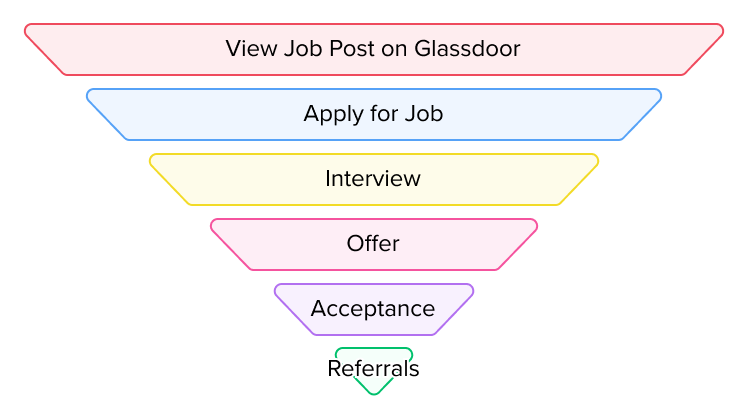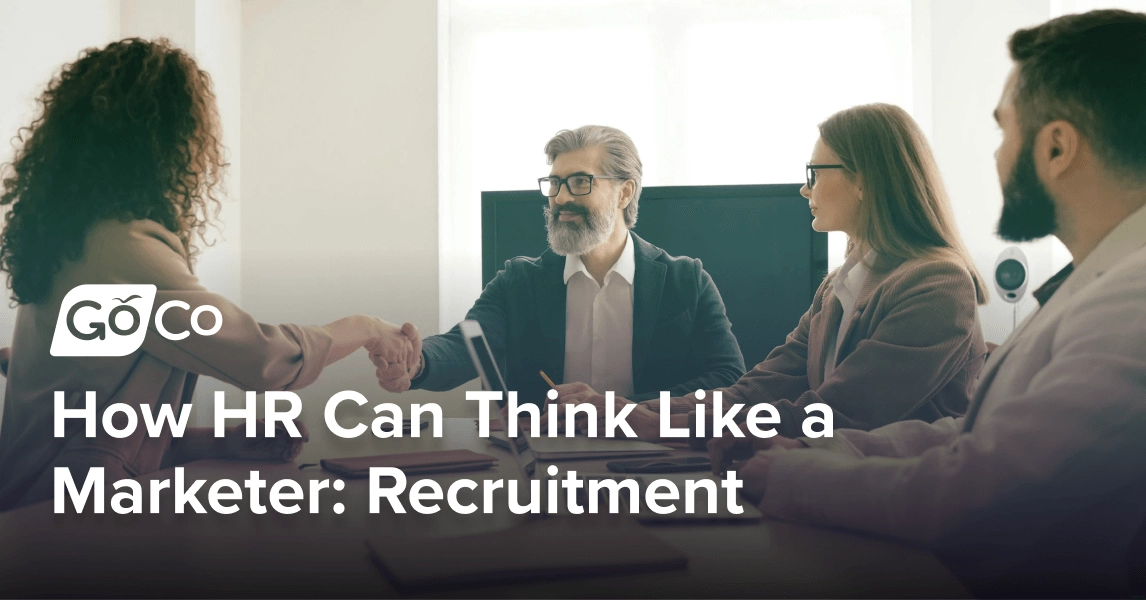How HR Can Think Like a Marketer: Recruitment
Learn how marketing concepts such as the marketing funnel and buyer personas can transform your hiring process and improve employee acquisition and retention.
by Anna Coucke - March 22nd, 2023
Today’s HR professionals are adapting to more challenges than ever before, from the sudden rise of remote work to the Great Resignation. When it comes to hiring and retaining employees, HR departments can look to practices that marketers use to connect, build relationships, and ultimately acquire customers.
In this series, GoCo’s marketing team leaders explain some of their favorite marketing concepts and best practices, along with how they can be applied in the HR landscape. In this article, we will explore marketing practices that can be applied to recruitment.
The Marketing Funnel Journey
The first marketing concept that can be used in HR is called the marketing funnel. Marketers think about the path to purchase as a funnel: at the top, people become aware of your brand, they engage with it, and then they move down to the bottom of the funnel to eventually buy.
We think about this as being shaped like a funnel because a lot of people will start off at the very top, but as you move closer to the desired end result, fewer and fewer people will move through to the next step.
An example marketing funnel, from top to bottom, may look like this:
A Facebook ad is placed that a large number of people will see.
A few of these people will then click on the ad and travel to the advertised website
Only a very few people end up actually purchasing the product
A small number of people who purchase recommend the product

Each step through the funnel is called a conversion. We calculate the rate at which each prospect moves through that funnel into a conversion rate. So, of all the people that view the Facebook ad, about 5% might click on it. Of those who click on the ad, maybe 10% browse the website, and so on. Each of these is what we call a conversion rate.
We marketers have goals for conversion rates at each step in order to figure out how many people need to move through each step of the funnel. That's how we calculate budgets and figure out how much traffic is needed in order to hit purchase goals.
Creating a Recruitment Funnel for Top Talent
You may be wondering how all of this applies to HR. The fact is that you can think of recruiting as a funnel too! Here’s what it may look like:
Candidates become aware of an employer by viewing job descriptions
They apply and interview
A job offer is extended
In most cases, the offer will be accepted
Some of those who accept will recommend your employer to other people.

By thinking of recruiting as a funnel, you can set goals and measure conversion rates at every step in the same way that marketers do. You can use those to forecast the number of post views that you need. So, if you know you are trying to fill a position, you can start to model how many people you need to actually see your ad in order to successfully fill the job.
By looking at historical data, you can find conversion rates that allow you to determine how many job post views, phone screens, and interviews are needed on average to fill a role, which helps you set a budget and determine the overall cost to acquire talent. GoCo’s Applicant Funnel Calculator helps you easily calculate your conversion rates and compare those to benchmarks – no math required!
Once you have found your conversion rates in each section of the funnel, you may be wondering what a good conversion rate to aim for is. A survey from Jobvite found that on average across all industries, 11% of careers page or job posting visitors end up applying.
Since this figure is across all industries, you might want to find benchmarks specific to your industry, because it could vary dramatically from one to the next. However, this is a good place to start.
If you use the Applicant Funnel Calculator and find that your application rates are lower than 11%, don’t worry – there are a few things that you can do to improve.
Critical HR Statistics 2023
Download the FREE infographic!
Stage 1: Job Post to Application
The first thing to consider is polishing up your employer brand. It’s important to know that the brand you're projecting out to visitors to your website is going to have a really heavy impact on whether people feel like applying. Make sure that your company culture is accurately represented on your website so that applicants get an idea of what it is like to work at your company.
Remember that the hiring process is a two-way street, and jobseekers want to work at a place they feel excited and proud to be a part of. So, make sure that your careers page is reflecting your brand in a way that is representative of your culture, and update it ASAP if it isn’t.
Next, consider improving job descriptions. One way to do that is to focus on inclusion, particularly in the language used. It’s helpful to add information like that applicants don't need to meet 100% of the listed criteria in order to apply. We know there's some gender bias when people think that they have to meet all the criteria, particularly for women.
Stage 2: Application to Interview
The second part of the recruitment funnel is the application to interview stage. Jobvite's survey tells us that on average, 12% of applicants progress from the application to the interview stage. If you're below that average, focus on middle funnel activities, such as your process for scheduling. Emailing back and forth and struggling to find a time that works for everyone can create friction and frustration.
At GoCo, we saw that adopting a tool like Calendly streamlined our booking process by letting people book directly on our talent acquisition coordinator’s calendar. The result was that we got twice the response rate on our outreach.
Finally, consider using surveys through tools like SurveyMonkey to offer an incentive in exchange for candid feedback. If someone applies and doesn't make it to the interview process, or if a candidate interviews and either doesn't make it to the final stage or rejects an offer, you can offer them a small incentive (like a $5 Starbucks gift card) in exchange for their feedback, which allows you to gain some major insights.
Stage 3: Interview to Offer
In the interview-to-offer stage, an average of 17% of candidates progress. This is where you should focus on your ideal candidate criteria, because if a large percentage of people are making it to an interview and then get lost in that process, that’s a sign that the right candidates aren’t progressing through the funnel.
Spend more time with the hiring managers and have them give you a rubric that tells you exactly what criteria they're going to be evaluating. This allows you to ensure that the process is equitable, every candidate is being held to the same standard, and that you know what you're selecting for.
Stage 4: Offer to Acceptance
Finally, an average of 89% of candidates progress from offer to acceptance. If yours is a lot lower, try to spend time understanding why candidates might reject, and consider a more expensive gift card incentive for completing either an anonymous in-depth survey or an in-depth interview. That’s a great way to get really candid feedback.
Buyer Persona
Next, let’s discuss how you can not only recruit better, but recruit more quality hires by using a concept that we in marketing call quality of hire, which is a way of measuring the value that a new hire brings to your organization.
You might measure this by considering engagement, productivity, retention, or their overall impact on the business. Overall, it’s a way to show there are measures in place to know whether you've made a good hire or not.
There is another concept that marketers use called buyer persona, which allows us to paint a picture of what an ideal customer looks like. You can think about it like a vision board for a target market.
For example, a great fit for GoCo’s buyer persona is an HR professional in a small department (possibly the only person in the department) who is struggling with paper and spreadsheets and with too much employee onboarding pain. In recruiting, you can use the same vision board philosophy to identify and zero in on an ideal quality of hire for each role or each department that you're hiring for.
Creating an Ideal Candidate
When building a buyer persona, we look at all kinds of traits such as personality type, goals, and what value our product brings to them. With recruiting, you can apply this same philosophy to your hiring goals.
So, if you have a target role that you're hiring for, this is a great way to go beyond just a job description and actually paint a picture of the ideal target.
Some of the things you will want to include are:
Broad strokes on information such as education and work experience. For example, while a candidate with a formal education or a certain amount of experience is nice, there are more desirable traits that we want them to possess.
Personality traits and strengths. When hiring at GoCo, we like to use the DISC personality profile to pinpoint a candidate’s strengths and weaknesses.
Motivations, ambitions, pet peeves, and values. We want to know what's important to them and what motivates them. These tell you a lot about a candidate’s personality and what environment they work best in.
On the other hand, don’t include things like demographics, appearance, familial status, or anything else that could introduce bias. If you are including a photo, focus on representing the journey rather than the appearance of the person.
Final Thoughts
By thinking like a marketer and integrating the marketing practices of marketing funnels and buyer personas into recruitment, you gain a better understanding of your hiring process, find areas that may be causing friction, and ultimately improve the quality of your candidates.
Streamline your hiring even further and make the best first impression with GoCo’s hiring and onboarding, which allows you to send offer letters and onboarding documents, collect e-signatures, provide self-service benefits selection, and more – all in one place.
Recommended Posts
How HR Can Think Like a Marketer: Engagement
Blog Articles
Think Like a Marketer Series: Retention
Blog Articles
Search...
Product
GoCo
Resources
Articles
eBooks
Webinars
Customer Stories




![How to Write Job Postings That Get Great Candidates in 2025 [+Template]](/img/containers/assets/goco/featured_images/posts/how-to-write-job-posting.png/f7e6aa15847d2324dbf2282a887f4808/how-to-write-job-posting.png)